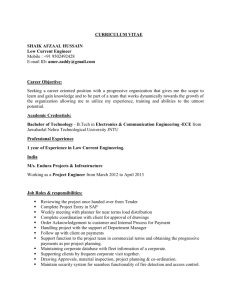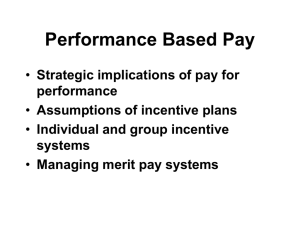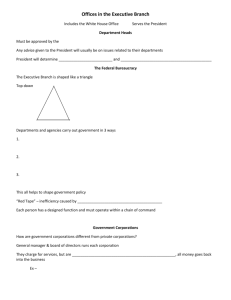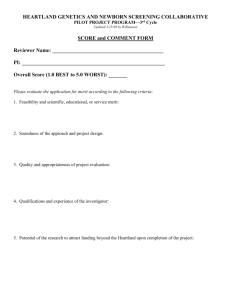Lecture 10 - Human Resource Management.
advertisement
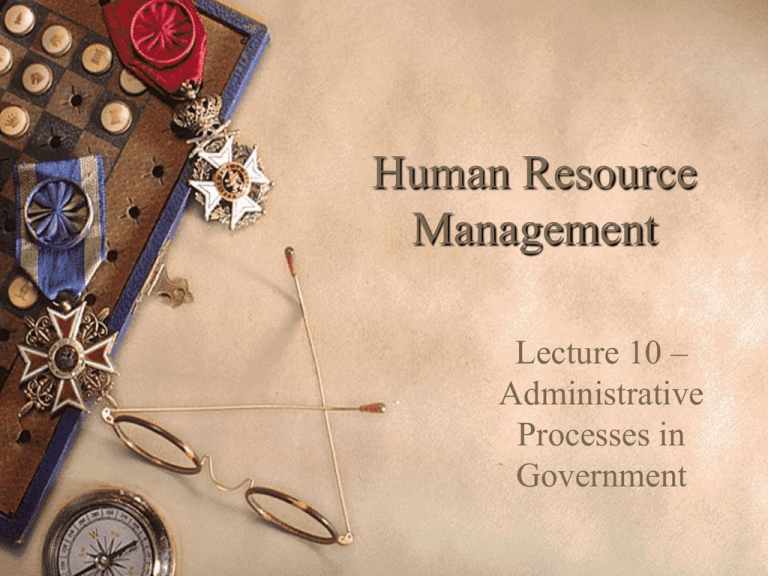
Human Resource Management Lecture 10 – Administrative Processes in Government Keynote: The Adventures of a Young Man as a Personnel Technician Read Jay Shafritz’s story. – Librarian. – Personnel technician. – Recruitment and examination technician. – Graduate assistant. – Assistant professor of public administration. The Personnel Function The function of a personnel staff, or even an entire personnel agency, is service to line management. Typical services include recruiting, selection, training, evaluation, compensation, discipline, and termination. Personnel is a collective term for all of the employees in an organization. Word is of military origin. The Personnel Function Personnel is also commonly used to refer to the personnel management function or the organizational unit responsible for administering personnel programs. Personnel administration – technical aspects of maintaining a full complement of employees within an organization. Personnel management – also concerns itself with how motivated and productive the personnel are. The Personnel Function The personnel function is currently evolving from a clerical function into an in-house consultant to management on labor relations, job redesign, EEO provisions, organization development, productivity measurement, and other pressing concerns. In the majority of U.S. jurisdictions this transformation is only just underway. The Personnel Function The key problem for personnel management is the balancing of several contradictory values. – Merit or neutral competence, executive leadership, political accountability, managerial flexibility, representativeness. Maximizing some of these values requires arrangements poorly suited for other values. These matters are further complicated by the rise of public-sector collective bargaining, which emphasizes employer-employee codetermination of personnel policy. Recruitment. Recruitment is the process of advertising job openings and encouraging candidates to apply. Designed to provide organizations with an adequate number of viable candidates to make a selection. The main objective: the generation of an adequate number of qualified candidates. Not all positions are open to entry-level applicants. Merit selection. Selection is the oldest function of public personnel administration. Pendleton Act mandated that all examinations for merit be practical in character. Primacy of practicality often breached in practice but reaffirmed in Griggs v. Duke Power Company (1971). “Test must measure the person for the job, not the job for the person.” Extended to public sector in Equal Employment Opportunity Act of 1972. Merit selection (contd.). Job relatedness is now the paramount consideration in developing a selection device. The legality of any test hinges on its capability in predicting job success. Validation is the process of demonstrating how well the testing device actually can predict success on the job. In the United States, every important public issue becomes a legal problem. Position Classification and Pay Example: A large municipal hospital on the East Cost of the United States once employed a janitor to perform brain surgery. Moral: position classification systems can create much dysfunctional and sometimes silly activity. Position classifications are formal job descriptions that organize all jobs in a civil service merit system into classes on the basis of duties and responsibilities, for the purposes of delineating authority, establishing chains of command, and providing equitable salary scales. Position Classification and Pay Position classification principles. – Positions and not individuals should be classified. – The duties and responsibilities pertaining to a position constitute the outstanding characteristics that distinguish it from, or mark its similarity to, other positions. – Qualifications with respect to education, experience, knowledge, and skill necessary for the performance of certain duties are determined by the nature of those duties. Position Classification and Pay Position classification principles. – The individual characteristics of an employee occupying a position should have no bearing on the classification of the position. – Persons holding positions in the same class should be considered equally qualified for any other position in that class. Position Classification and Pay Principles and practices of position classification go back to the scientific management movement before World War I. They have not been adapted since. A classification plan is nothing more than a time and motion study for the governmental function. Duties divided into positions to prevent duplication and promote efficiency. Position is simply a set of duties and responsibilities, not a person. Position Classification and Pay Basic doctrines established before World War II. Current management science and theory ignored. Workforce no longer the same. Most of labor force are highly skilled technical and professional personnel whose duties do not fit in a classification. Even people at the bottom of the organizational hierarchy now have enough education and training to resist being treated like interchangeable parts. Performance Appraisal Performance appraisal is the title usually given to the formal method by which an organization documents the work performance of its employees. Most performance evaluation systems fail because of inherent subjectivity. Performance Appraisal Five functions. – Changing or modifying dysfunctional work behavior; – Communicating to employees managerial perceptions of the quality and quantity of their work; – Assessing the future potential of an employee to recommend appropriate training or developmental assignments; – Assessing whether the present duties of an employee’s position have an appropriate compensation level; and – Providing a documented record for disciplinary and separation actions. Performance Appraisal Five basic types of appraisal. – Supervisory ratings: most common, supervisor – – – – evaluates performance of subordinates. Self-ratings: individuals rate themselves using a standard form, narrative report, or work product. Peer ratings: each individual rates every employee in his or her division or office at a parallel level in the organization. Subordinate ratings: subordinates rate the performance of a supervisor. Group ratings: an independent rater, usually an expert, rates the performance of the entire work unit based on selected interviews or on-the-job visitations. Performance Appraisal The problem arises in the varying standards of supervisors. The good ones will do their subordinates a disservice by being honest. Seldom an adequate incentive in a public system for supervisor to be honest. Result: inflated ratings. Training Training has frequently been the victim of organizational neglect. – In a budget squeeze, training funds are cut in favor of mandated examination and training functions. Government Employees Training Act not passed until 1958. Most training programs skimp on evaluation. To properly evaluate, standards for performance have to be set prior to training. Training The essential question is whether or not a training effort has met its objective. Training system. – Training needs assessment. – Training program design. – Training program delivery. – Training program evaluation. Training Training formats. – Skills training. – Coaching. – Formal or informal classroom instruction. – Sensitivity or “T-group” training. – Job rotation. – Special conferences and seminars. – Modeling, games, and seminars. – Exchange and sabbatical programs. Training All forms of training are limited by the availability of funding. Remember, no statement of training accomplishment in an annual report can honestly be made unless it is supported by a sophisticated measure of evaluation. Management Development Management development is a hybrid of training and selection. Any conscious effort on the part of an organization to provide a manager with the skills needed for future duties such as rotational assignments or formal education experiences constitute management development. Management Development The secondary focus of management development is selection. The range of experiences, both on or off the job, that managers are expose to over the years leaves records in terms of specific scores or subjective evaluations upon which future advancements may be based. Management Development How does an organization establish criteria for selected inexperienced managers for development? Assessment centers. Management simulations and stress situations. The Bittersweet Heritage of Civil Service Reform The perversion of most civil service merit systems for private, administrative, and partisan ends is one of the worst kept, yet least written about, secrets in government. Oddly, the perversion of merit systems is a normal, even healthy, condition. The perversion may be essential if actual merit is to be rewarded. Netherworld of Public Personnel Administration Public personnel merit systems operate at three levels. – Formal system where most employees enter, perform, and advance on the basis of merit and the design of the system. – Political rewards system. – Scrupulous abuse to increase managerial flexibility. From Spoils to Merit Civil service reform movement. – Jefferson and philosophically hostile bureaucracy. Generally refused to remove appointees except for “malconduct”. – Jackson and the spoils system. – Advent of modern merit systems at once, a political, economic, and moral development. The Pendleton Act Passage of the Act aided by assassination of Garfield and Republican losses in 1882 election. The Act created the Civil Service Commission as the personnel management arm of the U.S. government. Subject to the administrative discretion of the president. Open competitive exams, probationary periods, and protection from political pressures. Not a total victory for reformers. Initially only covered 10 percent of positions. Gradual incremental increase in coverage. The Pendleton Act State and Local Reform Influenced by Pendleton Act, state and local governments began to institute merit systems. But, a very slow process. First two adoptions (New York and Massachusetts occurred) within two years, but it was 20 years before another state did it. It was not until well after World War II that most states installed merit systems. State and Local Reform City adoption also gradual. Now covers 88 percent of cities, 90 percent of counties. But on the books does not necessarily mean effective implementation. Rise and Fall of the Civil Service Commission Bipartisan commissions became common. At local level, commission became politically and administratively independent of the executive. – Goal: defeating influence of partisan spoils. City manager movement challenged rationale for the commission. But not all cities adopted city manager form of government. Rise and Fall of the Civil Service Commission Merit system has taken hold in most jurisdictions because: – Complexity of modern local government increased requirements for greater technical training. – Federal government threw its weight behind the development of forceful merit systems. Problem: Modern elected executives and public managers need more flexibility than is provided by an independent civil service commission. Civil Service Reform Act of 1978 Jimmy Carter. – Office of Personnel Management. – Merit Systems Protection Board. – Senior Executive Service. Changes more cosmetic than real. Civil Service Reform Act of 1978 Reinventing Public Personnel Administration Reinventing government. – Deregulated personnel policy by eliminating the – – – – Federal Personnel Manual. Given all departments and agencies authority to conduct their own recruiting and examinations. Dramatically simplified classification system. Allowed agencies to design own performance management and reward systems. Sought to reduce by half the time required to terminate federal managers and employees for cause. Patronage Appointments The Plum Book. – Presidential appointments at his or her discretion. 40,000 resumes every four years. Most thrown out. Positions require “patron.” Patronage Appointments Constitutionality of patronage. – Patronage unconstitutional (Rutan v. the Republican Party 1990). Reality: Still exists. Veteran’s preferences. – First Act 1865, disability. – Superceded in 1919, honorably discharged. – 1944, five point bonus on exams.
